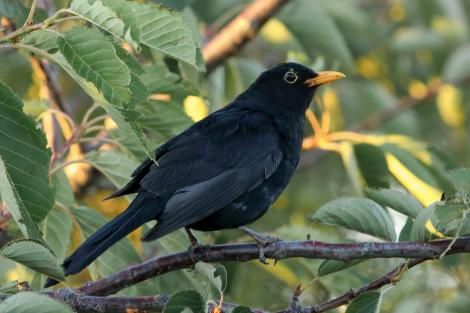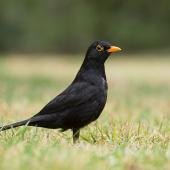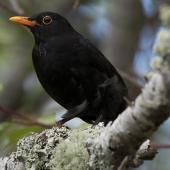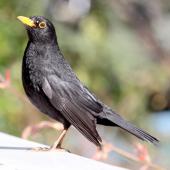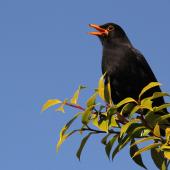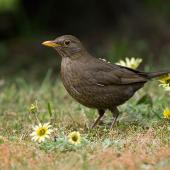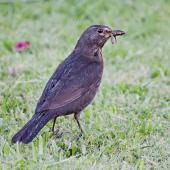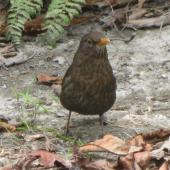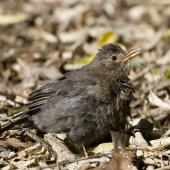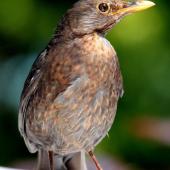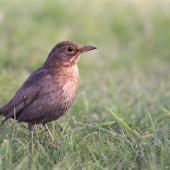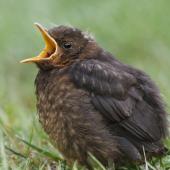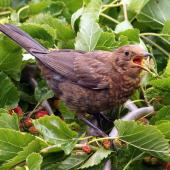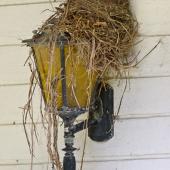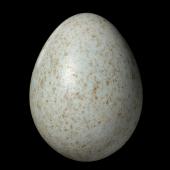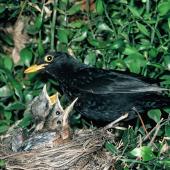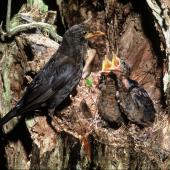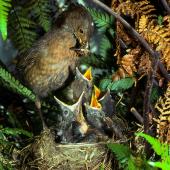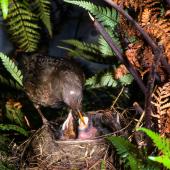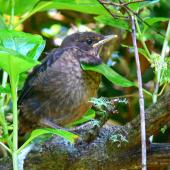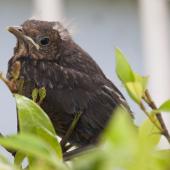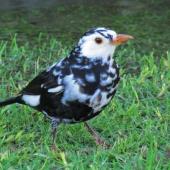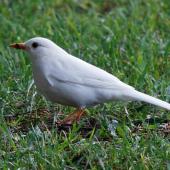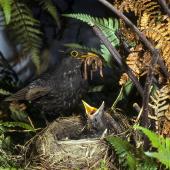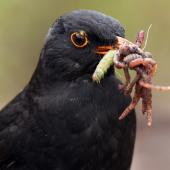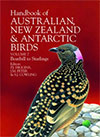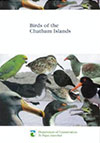Eurasian blackbird | Manu pango
Turdus merula Linnaeus, 1758
Order: Passeriformes
Family: Turdidae
New Zealand status: Introduced
Conservation status: Introduced and Naturalised
Other names: blackbird, common blackbird
Geographical variation: New Zealand birds are assigned to the nominate subspecies T. m. merula
The Eurasian blackbird was introduced to New Zealand, and is now our most widely distributed bird species. Adult males are entirely black apart from their yellow bill and eye-ring. Females and juveniles are mostly dark brown, slightly mottled on the belly. Blackbirds are common in a wide range of habitats including suburban gardens, farmland, woodlands and indigenous forests. Their song is given from winter to summer, with the singing male usually perched on a high branch, tree top or power line. They sing most in the early morning and evening. Blackbirds feed mostly on the ground on earthworms, snails, and insects. They also take berries while perched in foliage.
Identification
The blackbird is larger than a song thrush and is further distinguished from it by having darker, more uniform plumage, which is entirely black in adult males. Males also have a yellow bill and a yellow eye-ring around their dark eye. Adult females are mostly dark brown on their upperparts, light brown or grey on the throat, and dark brown with slight mottling on the breast and belly; their bill is light brown. Juveniles are similar to adult females, but with light mottling over the body.
Voice: the loud male territorial advertising song is mainly given from July to January. The song is similar to that of the song thrush, but without the repeated phrases that characterise thrush song. Other calls are given throughout the year, including a sharp quickly repeated alarm call made if a predator threatens.
Similar species: female and juvenile blackbirds may be confused with song thrush, but thrushes are smaller and slimmer, with creamy-white underparts (speckled with brown) from chin to undertail.
Distribution and habitat
Blackbirds are widespread throughout mainland New Zealand and off-shore islands from sea level up to about 1,500 m altitude, with a lower maximum altitude in the south. They occur in urban areas, farmlands, orchards and in lowland indigenous forests, being most abundant in urban gardens, parklands, farms and orchards. Blackbirds are also resident on most vegetated islands including Kermadec, Stewart, Chatham, Snares, Auckland and Campbell Islands; they occur as vagrants on Antipodes Island. The blackbird was the most widely reported bird species in the 1999-2004 Atlas of Bird Distribution in New Zealand, based on the number of grid squares occupied.
Population
Blackbirds were introduced to New Zealand from 1862 on, and are now abundant throughout the country. They are usually seen as single birds or pairs. Even where 20 or more blackbirds feed in close proximity, e.g. on damp sports fields near a shrub border, they do not behave as a flock.
Ecological and economic impacts
The main negative impact of Eurasian blackbirds is the damage they may cause to commercial fruit crops. They can also spread the seeds of weedy plants, and are often a nuisance in gardens by scattering mulch and newly planted seed beds and lawns. On the positive side of the ledger, blackbirds eat snails and slugs and other garden and horticultural invertebrate pests. They have no recognised impacts on native bird species, despite their ubiquitous distribution.
Breeding
Blackbirds breed as solitary, monogamous pairs nesting species, nesting between August and February, with a September – November peak in most localities. Males establish territories from about April-May. Nests are usually well concealed by foliage in the forks of shrubs or trees 3 to 10 metres above the ground and are a well-constructed woven bowl of grass, small twigs, moss, fragments of plastic bags, dead leaves and may be lightly lined with mud (compare with song thrush nest with characteristic mud lining). One or both sexes build the nest. Eggs are laid from August to December. Three or more clutches (typically of 3-4 greenish-blue eggs) may be laid during a season especially if an earlier clutch is lost. Incubation is shared by both sexes and takes 13-14 days. Both sexes feed the chicks. The nestlings are blind and naked when hatched. They are well feathered 12-13 days after hatching, and fledge when about 13-15 days old. Both sexes share with feeding of fledglings, which are often fed for several weeks after leaving the nest. A song thrush has been observed to have laid its eggs in the nest of a blackbird (an example of brood parasitism) but the two song thrush young that hatched out were ejected from the nest, which was subsequently deserted.
Behaviour and ecology
Blackbirds are commonly seen feeding on the ground in parklands, woodlands and suburban gardens, walking slowly or running short distances looking for food. They are often seen to ‘listen’ for food, e.g. earthworms, beneath the ground surface. They are strongly territorial, and may chase other species, including tui. Blackbirds are strong flyers and have reached all of New Zealand’s outlying island groups; they are not considered migratory in New Zealand. Moulting mostly occurs in late summer–autumn, with males ceasing to sing for the duration of their moult.
Food
Blackbirds mainly eat earthworms, insects, spiders, snails and slugs. They mainly forage on the ground on lawns or pasture, or among leaf litter under trees, hedges, forests or in woodlands. They also eat the small berries of some shrubs such as coprosma, and can eat ripening fruit in orchards.
Websites
http://www.nzbirds.com/birds/blackbird.html
References
Gill, B.J. 2010. Passeriformes. Pp. 275-322 in Checklist Committee (OSNZ) 2010. Checklist of the birds of New Zealand, Norfolk and Macquarie Islands, and the Ross Dependency, Antarctica (4th ed.). Ornithological Society of New Zealand & Te Papa Press,Wellington.
Heather, B.D.; Robertson, H.A. 1996. The field guide to the birds of New Zealand. Viking,Auckland.
Higgins,P.J.; Peter, J.M.; Cowling, S.J. (eds.) 2006. Handbook of Australian, New Zealand and Antarctic birds. Vol. 7, boatbill to starlings. Oxford University Press, Melbourne.
Khwaja, N.; Lloyd-Jones, D.J. 2015. Eurasian blackbird (Turdus merula) nest parasitised by song thrush (T. philomelos). Notornis 62: 41-44.
Robertson, C.J.R.; Hyvonen, P.; Fraser, M.J.; Pickard, C.R. 2007. Atlas of bird distribution in New Zealand, 1999-2004. Ornithological Society of New Zealand, Wellington.
Recommended citation
Armitage, I. 2013 [updated 2022]. Eurasian blackbird | manu pango. In Miskelly, C.M. (ed.) New Zealand Birds Online. www.nzbirdsonline.org.nz
Eurasian blackbird | Manu pango
- Breeding season
-
- Jul
- Aug
- Sep
- Oct
- Nov
- Dec
- Jan
- Feb
- Mar
- Apr
- May
- Jun
- Egg laying dates
-
- Jul
- Aug
- Sep
- Oct
- Nov
- Dec
- Jan
- Feb
- Mar
- Apr
- May
- Jun
Eurasian blackbird
- Social structure
- monogamous
- Breeding season
-
- Jul
- Aug
- Sep
- Oct
- Nov
- Dec
- Jan
- Feb
- Mar
- Apr
- May
- Jun
- Nest type
- woven cup
- Nest description
- Tightly woven bowl of grass, small twigs, lichen, wool, moss, dead leaves and lightly lined with mud.
- Nest height (min)
- 3.00 m
- Nest height (max)
- 10.00 m
- Maximum number of successful broods
- 5
- Clutch size (min)
- 3
- Clutch size (max)
- 4
- Mean egg dimensions (length)
- 28.00 mm
- Mean egg dimensions (width)
- 20.00 mm
- Egg colour
- Bluish-green or pale blue or greenish with dense freckled markings
- Egg laying dates
-
- Jul
- Aug
- Sep
- Oct
- Nov
- Dec
- Jan
- Feb
- Mar
- Apr
- May
- Jun
- Interval between eggs in a clutch
- 1day
- Incubation behaviour
- shared
- Incubation length (min)
- 12days
- Incubation length (max)
- 16days
- Nestling type
- altricial
- Nestling period (min)
- 12 days
- Nestling period (max)
- 14days
- Age at fledging (min)
- 12days
- Age at fledging (max)
- 15days
- Age at independence (min)
- 28 days
- Age at independence (max)
- 31 days
- Age at first breeding (typical)
- Probably 1 year
- Maximum longevity
- 5 years
- Maximum dispersal
- Juveniles disperse over 10 kms




